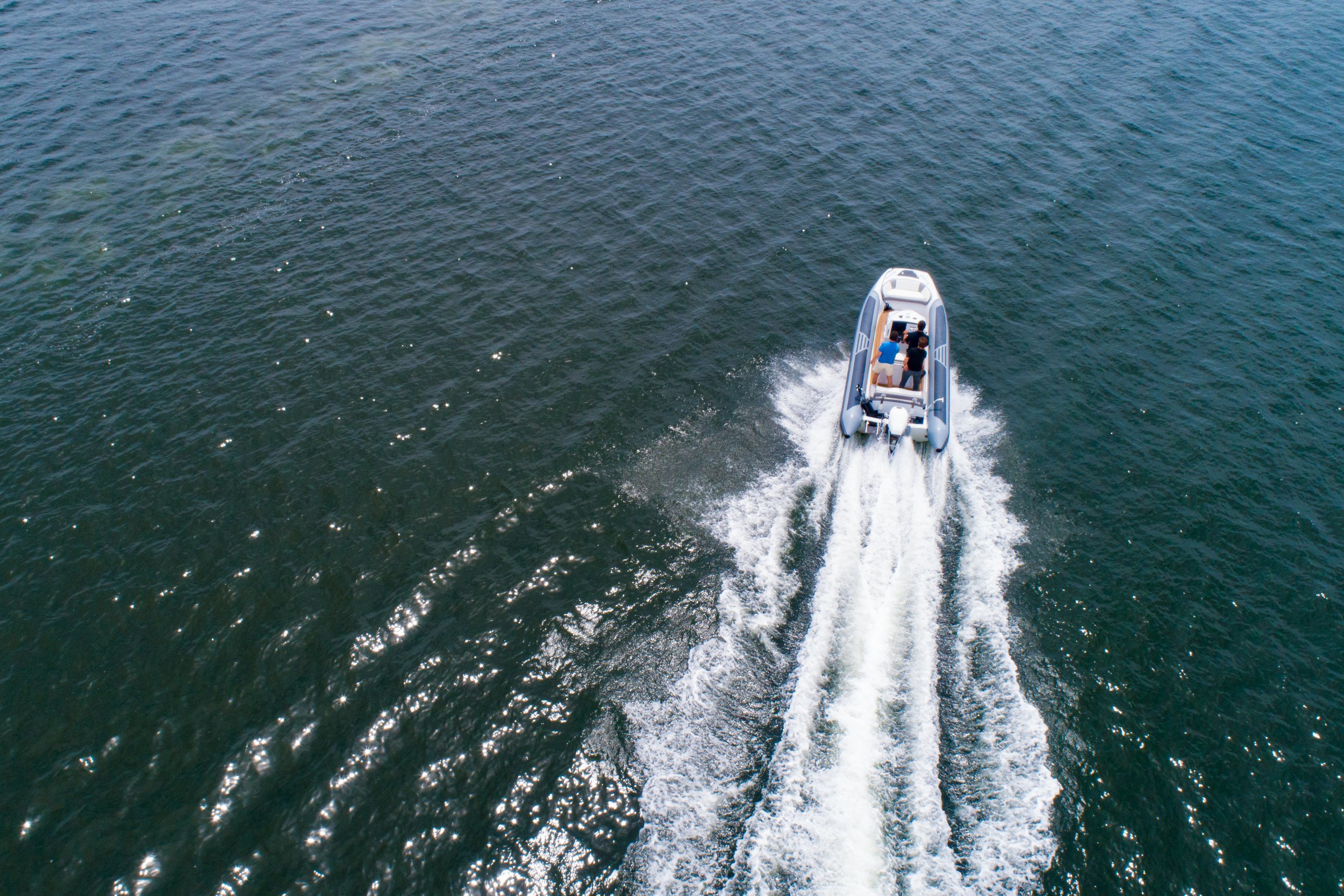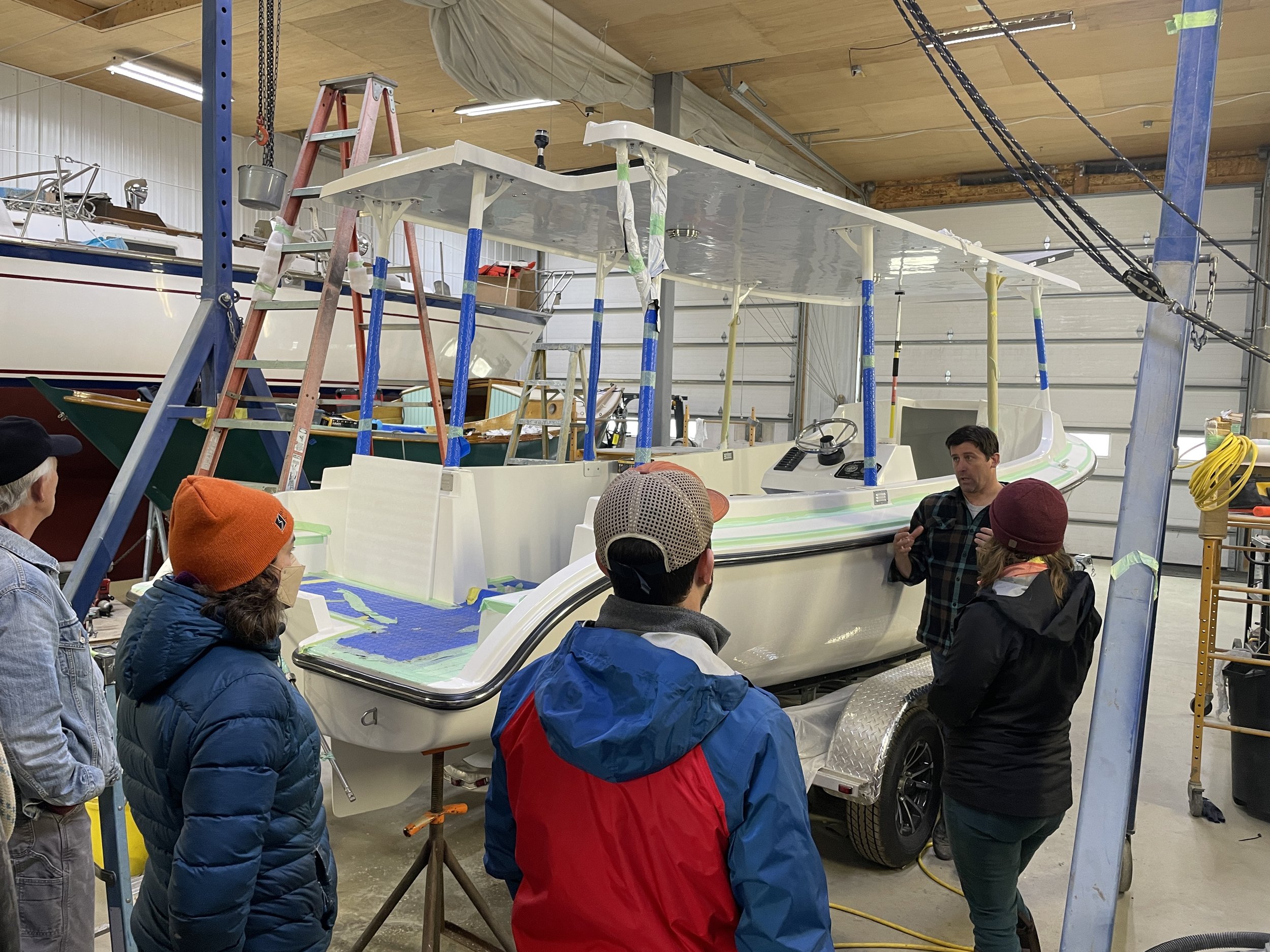Electric boats: the wave of the future
Going 40 knots using a Flux 100 horsepower electric motor. PHOTO: JACK SULLIVAN/THE ISLAND INSTITUTE
By Amy Paradysz
Sean Tarpey, owner of Rumery’s Boat Yard in Biddeford, has been watching the evolution of electric propulsion for more than 20 years, waiting for the day when boaters can use electric boats the same way they do any other vessel. “Now we are right at the verge of having products that will work and that people will be happy with,” Tarpey says. “The goal is to have someone using an electric motor and not having to change their habits on the water.”
Electric pleasure boats are available for rent at Maine Electric Boat Company out of Rumery’s Boat Yard on the Saco River in Biddeford. PHOTO: JACK SULLIVAN/THE ISLAND INSTITUTE
Sam’s son, Matt Tarpey, inherited the electric propulsion obsession and says, “I would expect some exciting things in 2023 and even more so in 2024.”
As founder of Maine Electric Boat Company, Matt Tarpey started out with 4- and 10-passenger rentals on the Saco River that are as easy to drive as a golf cart and quiet enough not to disturb wildlife while moving at top speeds of 45 mph. He sourced the boats from Canadian Electric Boat Company, now Vision Marine Technologies. While he continues the rental business as a way to introduce people to electric motors, he’s a few years into research and development with electric motor company Flux Marine of Bristol, Rhode Island.
“Flux has the best outboard motor I’ve ever used, including gas or diesel motors,” he says. “It’s built to be rugged so that people will be happy with the shift to electric. For 2023, we’re focused on deploying boats in the 40-to 70-horsepower range. I’m looking forward to people seeing that not only are these motors cleaner and quieter, but they’re more functional—they’re faster, their acceleration is better, and there will be less maintenance. We are, piece by piece, starting to develop the product lines that will replace a lot of internal combustion engines, starting with outboards.”
To connect with working waterfront users and better understand how electric boats work for their needs, Maine Electric Boat Company works closely with The Island Institute, a 40-year-old environmental nonprofit based in Rockland.
“Given the instability of fuel prices, electrification seems like a good arrow to have in the quiver in terms of responsiveness to change,” says Lia Morris, community development officer for The Island Institute.
In collaboration with Pendleton Yacht Yard in Isleboro, The Island Institute has ordered a 13-foot rigid inflatable boat (RIB) with a 40-horsepower fully electric Flux motor. It is expected to arrive early this summer.
“Our plan is to get as many people as possible—policymakers, aquaculture farmers, harbor masters, people who run sailing programs—out there to see that it works,” says Morris.
Many of the existing electric boats in Maine are skiffs used to get out to larger boats, where the electric battery can be stored under a seat. PHOTO COURTESY OF THE BOAT YARD
While electric boats are cleaner, quieter and require less maintenance than their gas-powered equivalents, they are also more expensive—initially.
“When you’re buying an electric motor and battery packs, you’re essentially buying your fuel up front,” says Morris. To help lower the barrier of that upfront investment for marine businesses, organizations and municipalities serving the blue economy, The Island Institute offers Spark grants of up to $4,000 and hopes to eventually offer larger grants toward electrification efforts.
Based on survey results and visits to boatyards, Morris estimates that the work of converting sailboats and launches to electric motors has been happening in Maine for nearly two decades, focused on small recreational boats.
Over the past year, The Boat Yard, a Torqeedo electric motor dealer on the Cousins River in Yarmouth, has encouraged local oyster farmers to take these motors out for test drives on their skiffs.
“Electric motors work out really well for aquaculture, keeping the ocean pristine,” says Chad Strater, who coowns The Boat Yard with Nick Planson. “There’s so much excitement about electric boats and so many diverse users who are a little ahead of the technology right now. The excitement is driving the innovation.”
Some electric motors, like this Torqeedo, are small enough to carry by hand and store under a seat. PHOTO: THE BOAT YARD
What if that lithium ion battery pack could also be used on your snow bike? Or work like a backup generator for your home? That’s where The Boat Yard and Shred Electric, complementary businesses on the Cousins River, are headed. As part of this spring’s Green Home + Energy Show’s Electric Vehicle Expo, they brought a Ford F-150 Lightning electric pickup truck with an electric snow bike on deck and towing an inflatable boat equipped with an electric motor.
“We had the whole suite,” Strater says. “You can plug the bike and the boat into the truck, which means that at a fast-charging station, you’d be charging everything at once.”
No one is going to be hauling a snow bike and a boat on the same excursion—which is exactly the point: Most electric boats are hauled in the fall and stored in the winter, and, as Strater points out, that battery needs to be maintained by using it. Shred Electric is working with Maine Technology Institute, Coastal Enterprises Inc. (CEI) and Sea Meadows Marine Foundation and manufacturers like Ruffian Snowbikes to develop swappable or multi-use batteries. Think about power tools with interchangeable batteries and imagine the same practicality when it comes to a single electric motor that can be used on a skiff, a snow bike and—soon—a work buggy or race cart.
For other uses—including larger boats or longer trips—marina charging will be a growing necessity. Using electrification grant funding from Maine Technology Institute, The Island Institute is looking into how many wharfs are ready with charging infrastructure, how many are close to ready and how many have far to go.
“We want to figure out the shoreside charging situation and the response in cold temperatures before we shout from the rooftops that this works for everybody,” Morris says. “Large-scale access to the technology isn’t quite there yet.”
But it’s close.
While Maine Electric Boat Company works with Flux Marine on motors, The Boat Yard in Yarmouth has been developing workboat solutions with Torqeedo, Photon Marine and Buxton Boatworks.
Public quick-charging pedestals have started popping up at larger commercial wharfs, including near Casco Bay Lines in Portland and the Department of Marine Resources in Boothbay. The Boat Yard says that Aqua superPower, which is working on a global-scale network of waterfront charging, is talking about installing fast chargers at Maine marinas.
Meanwhile, Maine is a national leader in thinking about the workforce aspects of marine electrification. The Island Institute is developing three short training courses in partnership with the Maine Community College System, Mid-Coast School of Technology, Kennebec Valley Community College, Bayside Marine and Maine Electric Boat. Level 1 is available on The Island Institute website and provides 90 minutes of basic information for general audiences age 15 and up. Level 2 will cover electrical theory for boatyard technicians and Level 3 will certify technicians to service electric motors as the demand rises.
“Workforce training is an important piece,” Morris says. “We’re also in conversations that may lead to hull manufacturing. With Maine being a place steeped in boatbuilding history, we’re looking at whether there are ways to bring back some of that surrounding electric boats.”
Progress reports
Belmont Boatworks
Waldo County company Belmont Boatworks assembled and launched Solar Sal 24—the first completely solar-powered powerboat designed for multiple-boat production—last spring. “We’re just finishing building our third now,” says founder Dan Miller. The Solar Sal prototype has a solar canopy and battery packs, designed by marine architect J.F. Bedard of Florida and built for Sustainable Energy, a company owned by David and Harriet Borton.
Casco Bay Lines
Casco Bay Lines is replacing two of their diesel ferries with diesel-electric propulsion system vessels. The replacement for Machigonne II, which goes back and forth between mainland Portland and Peaks Island, is slated to be in service in 2024, eliminating an estimated 800 metric tons of carbon dioxide a year. The replacement for the Maquoit II, which serves the Down Bay islands, will eventually eliminate an estimated 1,000 metric tons annually.
Solar Sal 24, a solar powerboat, was assembled and launched in Liberty. PHOTO: LIA MORRIS/THE ISLAND INSTITUTE
This article appeared in the Summer 2023 edition of Green & Healthy Maine. Subscribe today!
Find Maine experts that specialize in healthy, efficient homes in the Green Homes Business Directory.






